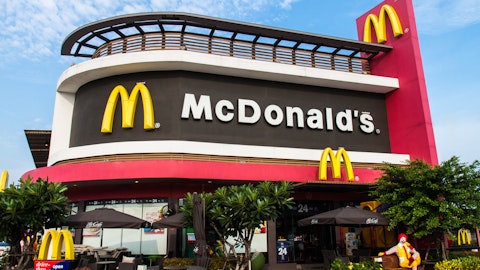Within product sourcing costs, as I just mentioned, supply chain leveraged 40 basis points. That was ahead of our expectations, and that was due to higher productivity and benefits we’re starting to realize from our efficiency initiatives and supply chain. SG&A in the fourth quarter did delever by 80 basis points. Now, that excludes the Bed Bath & Beyond expenses. But that was in line with what we had expected and was driven primarily by higher incentive comp, as well as our store payroll investment during the quarter. So, overall, for the fourth quarter, our 110 basis point increase in EBIT margin, that was 70 basis points above the high end of our guidance. We felt like this was a strong outcome, gives us confidence as we head into 2024, continue to expand operating margin.
And finally, the strength of Q4 did contribute to the 130 basis point increase in EBIT margin for the full year fiscal 2023. And that enabled us to ultimately exceed the high end of that original EBIT margin guidance for 120 basis point increase in fiscal 2023.
Ike Boruchow: Just a quick one for Michael. Just on real estate, you still sound very confident on 100 net new stores for 2024. You mentioned some things like lumpiness in openings over the next couple of years. I wonder if you could maybe just elaborate a little bit on that and maybe just update us on the overall real estate environment and what your pipeline looks like.
Michael O’Sullivan: Let me anchor my answer on the gross number of new store openings. We expect to open about 140 new stores on a gross basis this year. That includes relocating a couple of dozen of our older, oversized, less productive stores. As we’ve described previously, that program of relocations is pretty important. It’s going to be important to us in the next few years as we reposition ourselves away from some of our less attractive legacy real estate. Anyway, if you take 140 gross new stores and remove those relocations and remove any closures, then we expect our incremental number of new stores to net down to about 100. As I said in the prepared remarks, we have high standards and tight controls for the quality of the real estate where we open new stores.
Each potential location is analyzed carefully based on the traffic, trade area, demographics, and co-tenants. And based upon those detailed characteristics, we feel pretty excited about the new stores that we’re planning to open this year. Now beyond this year, it’s a little difficult to get specific, but I’d offer up a couple of comments. We typically manage our new store pipeline two to three years out. So we still have plenty of work to do on our 2025 new store pipeline, but so far I would say it’s shaping up well. It includes a number of additional former Bed Bath & Beyond stores that we didn’t pursue directly during the bankruptcy process, but instead have negotiated directly with the underlying landlords. And we’re excited about those locations.
Beyond 2025, the pipeline is going to depend on the availability of attractive real estate locations. Again, difficult to be specific, but given the weak outlook across bricks and mortar retail, there are reasons to think that that availability could be fairly strong.
Operator: Your next question comes from the line of Lorraine Hutchinson from Bank of America.
Lorraine Hutchinson: Michael, can you give us more color on what you see as the opportunity with the trade down or that slightly higher income customer? I’m interested in how you’re thinking about that opportunity and the actions you’re taking to address it.
Michael O’Sullivan: I would say that historically in off price, and certainly for us, the lower income shopper has been, A, or even B, major driver of growth. But since early 2022, that has not been the case. In fact, I would say that, for the last few years, it’s been clear that right now the growth in off price is being driven by higher income shoppers. That’s not a new revelation. We talked about that last year. In 2023, especially in the fall, we pursued a number of strategies to go after those shoppers, in particular focused on delivering a higher mix of recognizable brands and on elevating our assortments in specific businesses. Those strategies worked. They worked really well. But looking back, we could see that we could/should maybe have been even more aggressive.
Many of the areas that I’m talking about require that you make buying commitments well ahead of time. In other words, it’s more difficult to chase in some of those businesses. And that means that you have to commit further out. And that means you have to be prepared to take more risk. So although I’m happy with the success of the strategies we pursued, in retrospect, I think we should have leaned in more. We should have taken a little more risk. And we might have ended up actually with a slightly lower margin, but we could have driven more sales. So as we look at 2024, we see that as an opportunity. Again, the lead times are a little longer for many of those brands and those businesses. So I would say the opportunity is likely to be stronger in the second half versus the first.
I guess the last thing I would say is that we have always had a lower mix of higher income shoppers than some of our peers. We know this. It’s partly a reflection of where our stores are located. I think we’ve shared before that about 70% of our stores are in trade areas where the mean household income is less than $80 ,000. That footprint is not going to change in the short term. But what 2023 demonstrated is that we have enough higher income shoppers coming into our stores, but we can drive incremental sales if we offer great value on the recognizable brands, styles, and items that they are looking for. So we’re going to go after that business much more aggressively in 2024.




